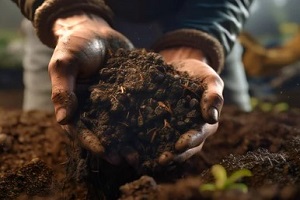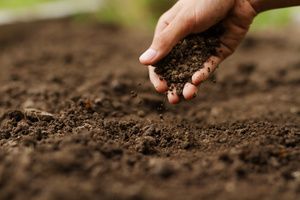 Loamy soil is widely considered the best type of gardening soil and is highly recommended for setting a garden up for success. What is so special about loam soil, and how can you transform soil that falls short into this desirable material?
Loamy soil is widely considered the best type of gardening soil and is highly recommended for setting a garden up for success. What is so special about loam soil, and how can you transform soil that falls short into this desirable material?
Defining Loam Soil
Before loam soil can be defined, it is important to understand the various types of soil you might encounter in a typical garden. There are three main components of soil – sand, clay and silt – and the amount of these particles found in your soil will determine its ability to retain and absorb water.
Sand
Sand particles are the largest particles that can be found in soil. Their size means they are capable of forming spaces in the soil that allow air to circulate and bring much-needed oxygen to the roots of the plants. However, sand falls short when it comes to retaining water.
Clay
Clay particles are the finest particles found in soil. This means that they pack together tightly, which does not allow much room for drainage or aeration. Where clay shines, however, is in its natural abundance of nutrients that can help plants grow and thrive.
Silt
Silt is made up of medium particles, falling somewhere in the middle of clay and sand in terms of size. Silt is known for its excellent fertility.
Loamy soil contains all three of these components in the right ratio to allow it to retain sufficient moisture for keeping plants healthy while enabling excess water to drain away from the plant to avoid causing problems with the roots. It also contains an abundance of nutrients.
Loamy soil is defined as having the following ratio of materials:
- Clay – Between 7 and 27%
- Silt – Between 28 and 50%
- Sand – Less than 52%
Note that this is not a precise ratio; the percentages of these components in a soil can vary within the stated ranges and still be considered loam. A more general rule that many casual gardeners follow is to aim for equal amounts of silt and sand with half as much clay.
How Can You Tell What Type of Soil You Have?
 Before you can create loamy soil, you need to know the type of soil you are working with. For a precise assessment, you can bring a sample to your county extension office to be tested. However, there is a simple test you can perform with your hands to determine the type of soil you are dealing with.
Before you can create loamy soil, you need to know the type of soil you are working with. For a precise assessment, you can bring a sample to your county extension office to be tested. However, there is a simple test you can perform with your hands to determine the type of soil you are dealing with.
Simply grab a handful of slightly damp soil and then squeeze it to form a ball. Watch what happens when you open your hand afterward. If your soil is sandy, it will not hold a ball shape and will simply slip through your fingers when you open your hand.
If your result is a loose and somewhat slimy ball that flattens when you open your hand, you are dealing with silty soil. Clay soil, meanwhile, forms a firm ball and holds its shape after you’ve opened your hand. With loamy soil, your hand will form a soft ball that crumbles when pressed.
Creating Loam Soil
Although it might seem logical, you cannot create loamy soil simply by balancing whatever components the soil you are dealing with is lacking – for example, by adding clay to sandy soil or adding sand to clay soil. Instead of creating loam, this will form a mixture with properties that are similar to cement, which is not conducive for digging or planting.
Instead, the solution is amending your soil with organic matter. Regardless of the type of imbalance the soil is experiencing, organic matter can help bring its properties closer to those of loamy soil. Some of the ingredients you can use include peat moss, composted manure, grass clippings, shredded tree bark, dried leaves or garden compost.
Unfortunately, this is not a set-it-and-forget-it process. Instead, you will need to amend the soil on an ongoing basis because plants will use up nutrients as they grow. In addition, water that runs off the soil will bring nutrients with it.
Soil that is heavily sand or clay will not turn into loam right away, so it is important to keep your expectations realistic. Amending it with organic matter will lead to improvements, but it may take several years before you can achieve optimal loamy soil.
Outlined below are some of the most effective methods for making loamy soil.
Add Organic Matter in Late Fall
After your harvest is over and your plants have died at the end of the fall season, apply two inches of organic matter across the surface of your garden. Then, water your plot until the organic matter is fully saturated. Leave the mixture in place throughout winter. When spring comes, use a shovel or tiller to turn the soil to a depth of 6 to 8 inches. This process should be repeated each year.
Mulch Around Your Plants
Another helpful approach is mulching around plants during the growing season. Commercial mulch that is made up of dry grass clippings, dry leaves or shredded hardwood bark are all good choices.
A couple of inches of mulch can help the soil remain moist and cool throughout the hottest days of summer and protects the roots of the plants while it decomposes. After harvesting, you can till or turn the soil to work the mulch deeper into it once it has decomposed.
Plant a Cover Crop
 In the fall, consider planting a cover crop to help enrich your soil. Sweet clover, buckwheat, rye grass and alfalfa are all popular choices. Your county extension office can provide advice on the best cover crops for your area. Once the crop has sprouted and grown three to six inches tall, till it under and then let your plot sit undisturbed through the winter. In spring, till or turn the soil six to eight inches deep as part of your planting preparations.
In the fall, consider planting a cover crop to help enrich your soil. Sweet clover, buckwheat, rye grass and alfalfa are all popular choices. Your county extension office can provide advice on the best cover crops for your area. Once the crop has sprouted and grown three to six inches tall, till it under and then let your plot sit undisturbed through the winter. In spring, till or turn the soil six to eight inches deep as part of your planting preparations.
Allow Annual Flowers and Vegetables to Decompose
When your annual flowers and vegetables have died in the fall, pull them out of the ground and set them on the top of your soil. Then, wet them completely and leave them to break down and decompose throughout the winter before working them into the soil in spring.
Reach Out to the Northern Virginia Soil Experts
Set the stage for success in your garden with high-quality soil from Dirt Connections. Contact us today to find out more about our Northern Virginia soil delivery and site preparation services.
Summary

Dirt Connections was started with one goal in mind: providing quality residential and commercial construction services to clients on time and on budget. Reach out for more information on how we can support your next project.
For your convenience our estimates are free and by appointment. Call 703-940-9949 for a free estimate today!



